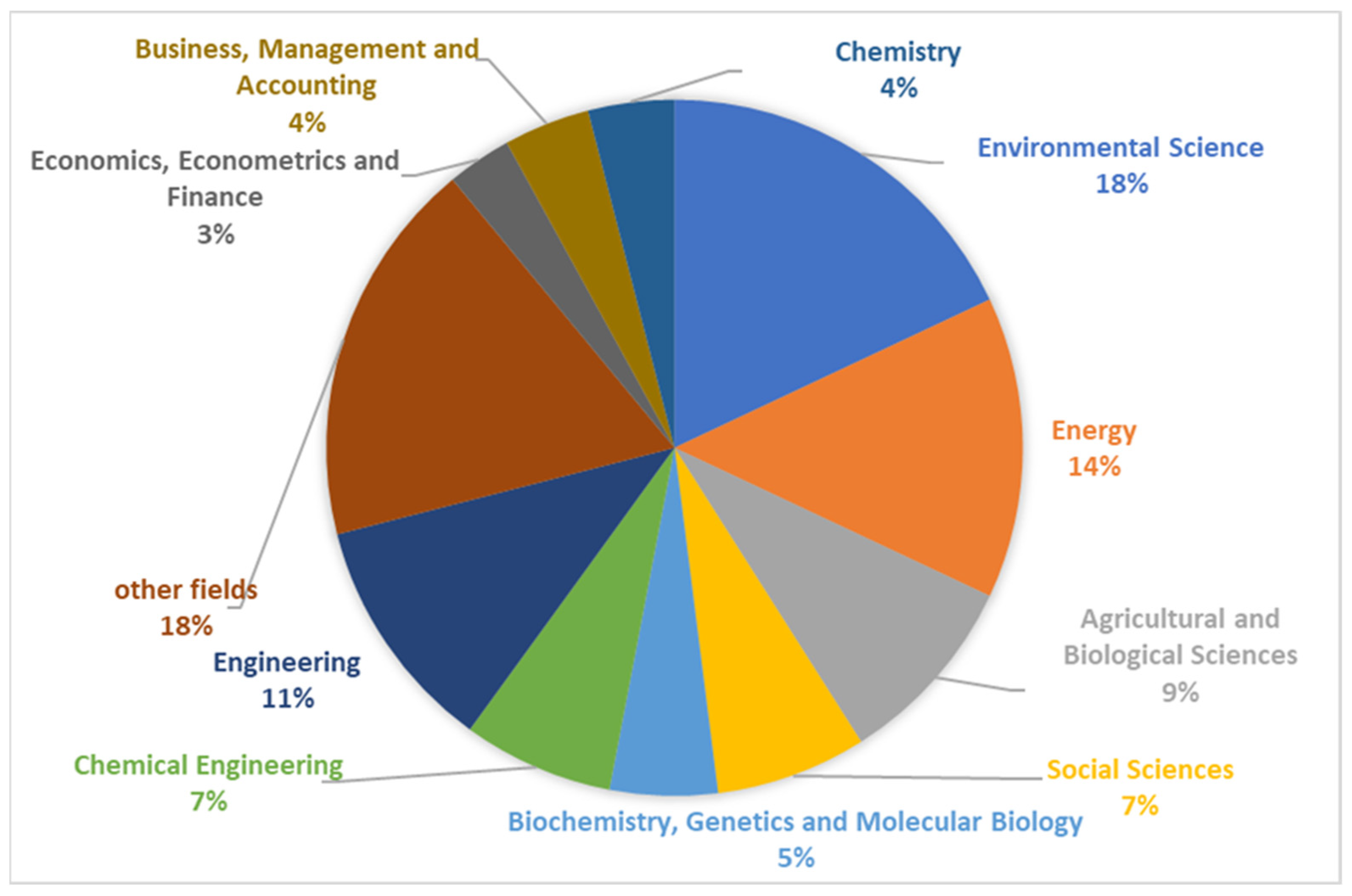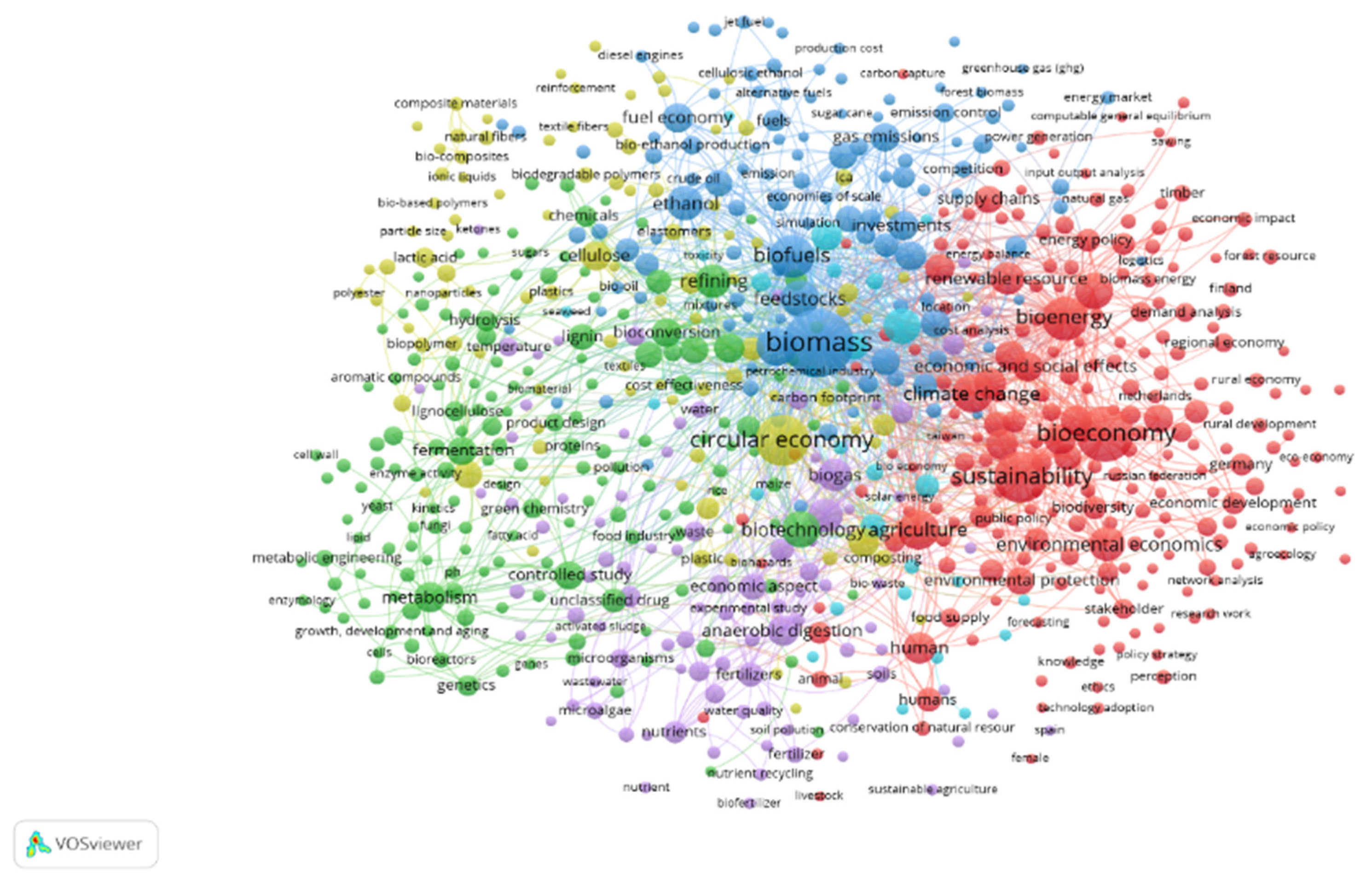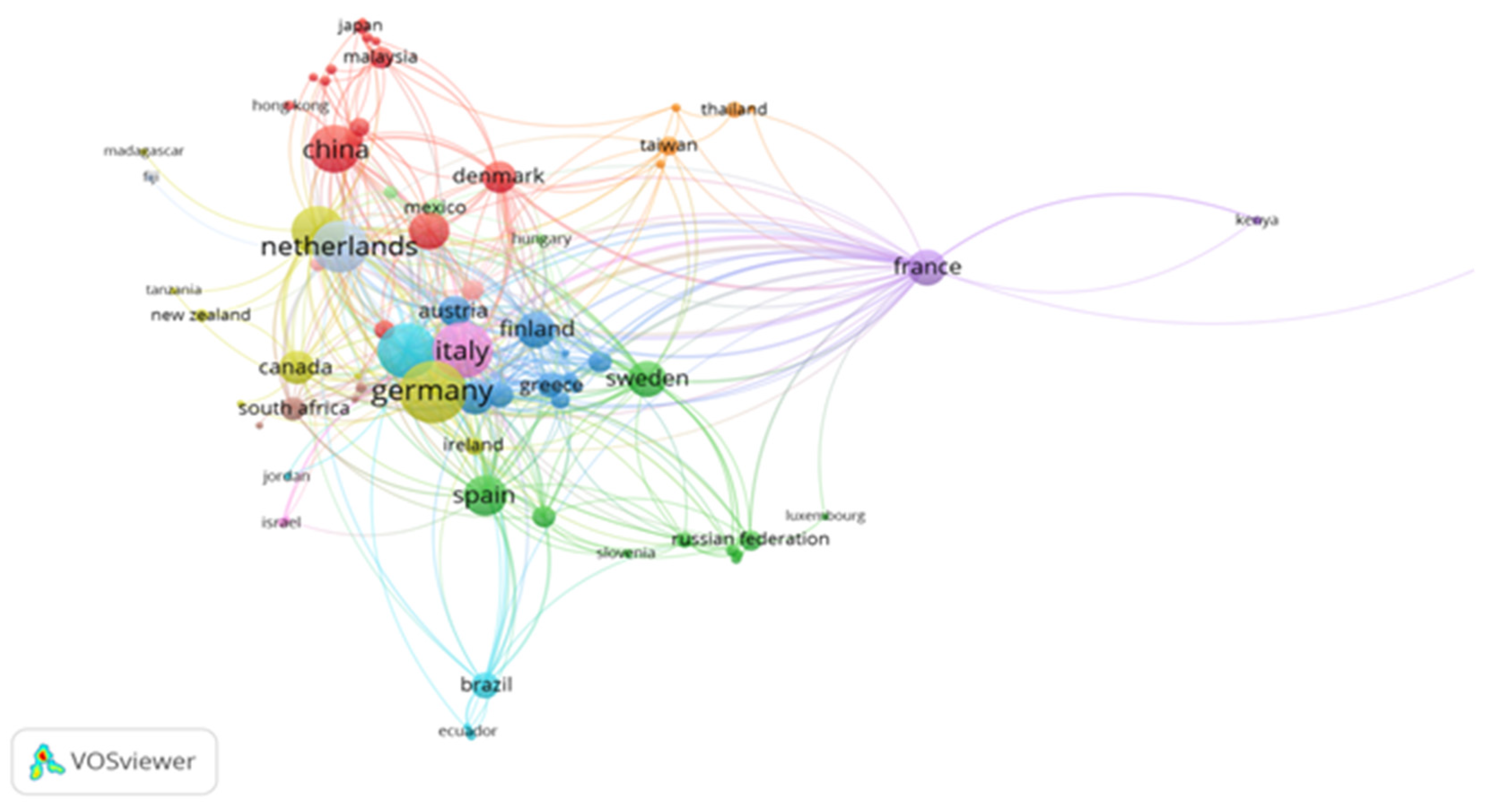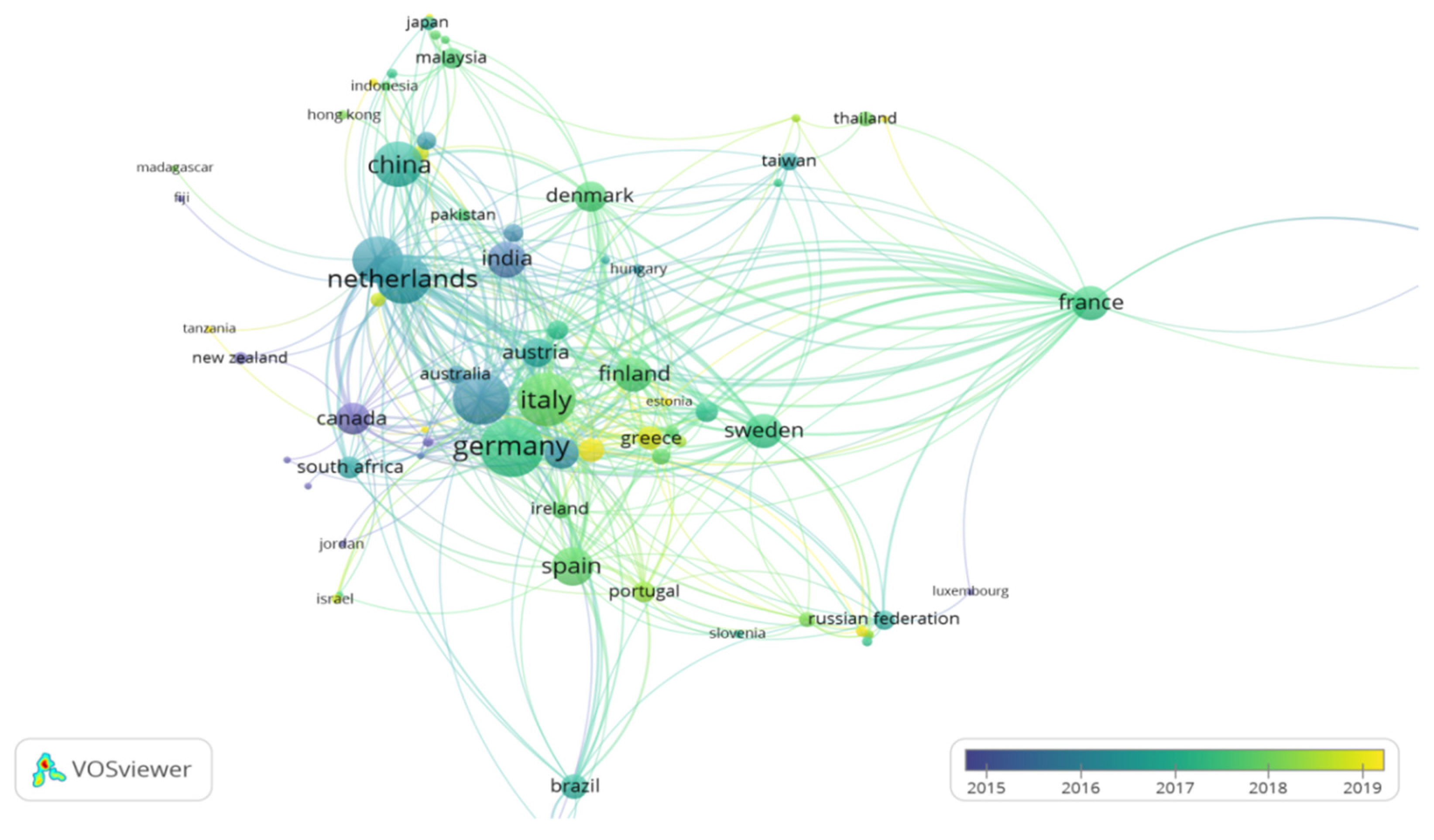The Knowledge Based Agricultural Bioeconomy: A Bibliometric Network Analysis
Abstract
:1. Introduction
2. Methodology Issues—Bibliometric Network Analysis
2.1. Scientific Areas
2.2. Time Period for Analysis of Reports
2.3. Type of Scientific Publications
- (a)
- Co-authorship analysis where the relevance of data is determined based on the number of co-authors.
- (b)
- Co-occurrence analysis where the correlation of data is determined based on the number of publications that appear together.
- (c)
- Citation analysis that determines the relevance of data based on the times that the authors refer to each other.
- (d)
- Bibliographic coupling analysis where the correlation of data is determined based on the number of reports shared.
- (e)
- Co-citation analysis which determines the relevance of data based on the times they are cited together
3. Results
3.1. Keyword Network Analysis
3.2. Country Network Analysis
4. Discussion
5. Conclusions
Author Contributions
Funding
Institutional Review Board Statement
Informed Consent Statement
Data Availability Statement
Acknowledgments
Conflicts of Interest
References
- McCormick, K.; Kautto, N. The Bioeconomy in Europe: An Overview. Sustainability 2013, 5, 2589–2608. [Google Scholar] [CrossRef] [Green Version]
- Vivien, F.-D.; Nieddu, M.; Befort, N.; Debref, R.; Giampietro, M. The Hijacking of the Bioeconomy. Ecol. Econ. 2019, 159, 189–197. [Google Scholar] [CrossRef]
- Purkus, A.; Hagemann, N.; Bedtke, N.; Gawel, E. Towards a sustainable innovation system for the German wood-based bi-oeconomy: Implications for policy design. J. Clean. Prod. 2018, 172, 3955–3968. [Google Scholar] [CrossRef]
- Hurmekoski, E.; Lovrić, M.; Lovrić, N.; Hetemäki, L.; Winkel, G. Frontiers of the forest-based bioeconomy—A European Delphi study. For. Policy Econ. 2019, 102, 86–99. [Google Scholar] [CrossRef]
- European Commission. Innovating for Sustainable Growth: A Bioeconomy for Europe; The European Commission: Brussels, Belgium, 2012; p. 3. [Google Scholar]
- Organisation for Economic Co-operation and Development (OECD). The Bioeconomy to 2030. Designing a Policy Agenda; Organisation for Economic Co-operation and Development (OECD): Paris, France, 2009; p. 12. [Google Scholar]
- House, W. National Bioeconomy Blueprint; White House: Washington, DC, USA, 2012. [Google Scholar]
- Sanders, J.; Langevald, H.; Kuikman, P.; Meeusen, M.; Meijer, G. (Eds.) The Biobased Economy: Biofuels, Materials and Chemicals in the Post-Oil Era; Routledge: Abingdon, UK, 2010. [Google Scholar]
- European Association for Bioindustries (EuropaBio). Building a Bio-Based Economy for Europe in 2020; European Association for Bioindustries: Brussels, Belgium, 2011. [Google Scholar]
- Golembiewski, B.; Sick, N.; Bröring, S. The emerging research landscape on bioeconomy: What has been done so far and what is essential from a technology and innovation management perspective? Innov. Food Sci. Emerg. Technol. 2015, 29, 308–317. [Google Scholar] [CrossRef]
- Lainez, M.; González, J.M.; Aguilar, A.; Vela, C. Spanish strategy on bioeconomy: Towards a knowledge based sustainable innovation. New Biotechnol. 2018, 40, 87–95. [Google Scholar] [CrossRef] [PubMed]
- Aguilar, A.; Bochereau, L.; Matthiessen, L. Biotechnology as the engine for the Knowledge-Based Bio-Economy. Biotechnol. Genet. Eng. Rev. 2009, 26, 371–388. [Google Scholar] [CrossRef] [PubMed]
- European Commission. A Sustainable Bioeconomy for Europe: Strengthening the Connection between Economy, Society and the Environment. Updated Bioeconomy Strategy; The European Commission: Luxemburg, 2018; p. 7. [Google Scholar]
- Bracco, S.; Calicioglu, O.; Gomez San Juan, M.; Flammini, A. Assessing the contribution of bioeconomy to the total economy: A review of national frameworks. Sustainability 2018, 10, 1698. [Google Scholar] [CrossRef] [Green Version]
- Mohanty, A.K.; Misra, M.; Drzal, L.T. Sustainable Bio-Composites from Renewable Resources: Opportunities and Challenges in the Green Materials World. J. Polym. Environ. 2002, 10, 19–26. [Google Scholar] [CrossRef]
- European Commission. Review of the 2012 European Bioeconomy Strategy: Office of the European Union; The European Commission: Brussels, Belgium, 2017. [Google Scholar]
- Duque-Acevedo, M.; Belmonte-Ureña, L.J.; Plaza-Úbeda, J.A.; Camacho-Ferre, F. The Management of Agricultural Waste Biomass in the Framework of Circular Economy and Bioeconomy: An Opportunity for Greenhouse Agriculture in Southeast Spain. Agronomy 2020, 10, 489. [Google Scholar] [CrossRef] [Green Version]
- Heimann, T. Bioeconomy and SDGs: Does the Bioeconomy Support the Achievement of the SDGs? Earth's Future 2019, 7, 43–57. [Google Scholar] [CrossRef] [Green Version]
- de Assis, C.A.; Gonzalez, R.; Kelley, S.; Jameel, H.; Bilek, T.; Daystar, J.; Handfield, R.; Golden, J.; Prestemon, J.; Singh, D. Risk management consideration in the bioeconomy. Biofuels Bioprod. Biorefining 2017, 11, 549–566. [Google Scholar] [CrossRef]
- Giurca, A.; Späth, P. A forest-based bioeconomy for Germany? Strengths, weaknesses and policy options for lignocellulosic biorefineries. J. Clean. Prod. 2017, 153, 51–62. [Google Scholar] [CrossRef]
- Lazarevic, D.; Kautto, P.; Antikainen, R. Finland’s wood-frame multi-storey construction innovation system: Analysing motors of creative destruction. For. Policy Econ. 2020, 110, 101861. [Google Scholar] [CrossRef]
- Scordato, L.; Klitkou, A.; Tartiu, V.E.; Coenen, L. Policy mixes for the sustainability transition of the pulp and paper indus-try in Sweden. J. Clean. Prod. 2018, 183, 1216–1227. [Google Scholar] [CrossRef]
- Lilja, K.; Moen, E. Orchestrating a new industrial field. The case of the Finnish wood-based bioeconomy. Int. J. Bus. Environ. 2017, 9, 266–278. [Google Scholar] [CrossRef]
- Bueso, Y.F.; Tangney, M. Synthetic Biology in the Driving Seat of the Bioeconomy. Trends Biotechnol. 2017, 35, 373–378. [Google Scholar] [CrossRef] [PubMed]
- Kuckertz, A.; Berger, E.S.; Brändle, L. Entrepreneurship and the sustainable bioeconomy transformation. Environ. Innov. Soc. Transit. 2020, 37, 332–344. [Google Scholar] [CrossRef]
- Scarlat, N.; Dallemand, J.F.; Monforti-Ferrario, F.; Nita, V. The role of biomass and bioenergy in a future bioeconomy: Policies and facts. Environ. Dev. 2015, 15, 3–34. [Google Scholar] [CrossRef]
- Diakosavvas, D.; Frezal, C. Bio-economy and the sustainability of the agriculture and food system: Opportunities and policy challenges. In OECD Food Agriculture and Fisheries Papers; OECD: Paris, France, 2019; Volume 136. [Google Scholar] [CrossRef]
- Bugge, M.M.; Hansen, T.; Klitkou, A. What Is the Bioeconomy? A Review of the Literature. Sustainability 2016, 8, 691. [Google Scholar] [CrossRef] [Green Version]
- Papavlasopoulos, S. Scientific reporting and measurement tools in Bibliometrics; Publisher Kallipos: Athens, Greece, 2015. [Google Scholar]
- Simkin, M.V.; Roychowdhury, V.P. Theory of citing. In Handbook of Optimization in Complex Networks; Springer: Boston, MA, USA, 2012; pp. 463–505. [Google Scholar]
- Moed, H.F. Citation Analysis in Research Evaluation; Springer Science & Business Media: Berlin/Heidelberg, Germany, 2006; Volume 9. [Google Scholar]
- Glanzel, W. Bibliometrics as a Research Field a Course on Theory and Application of Bibliometric Indicators. 2003. Available online: https://www.cin.ufpe.br/~ajhol/futuro/references/01%23_Bibliometrics_Module_KUL_BIBLIOMETRICS%20AS%20A%20RESEARCH%20FIELD.pdf (accessed on 22 March 2021).
- Konstantinis, A.; Rozakis, S.; Maria, E.A.; Shu, K. A definition of bioeconomy through the bibliometric networks of the scientific literature. AgBioForum 2018, 21, 64–85. [Google Scholar]
- Van Eck, N.J.; Waltman, L. Software survey: VOSviewer, a computer program for bibliometric mapping. Scientometrics 2010, 84, 523–538. [Google Scholar] [CrossRef] [Green Version]
- Paletto, A.; Biancolillo, I.; Bersier, J.; Keller, M.; Romagnoli, M. A literature review on forest bioeconomy with a biblio-metric network analysis. J. For. Sci. 2020, 66, 265–279. [Google Scholar] [CrossRef]
- Aristovnik, A.; Ravšelj, D.; Umek, L. A bibliometric analysis of COVID-19 across science and social science research land-scape. Sustainability 2020, 12, 9132. [Google Scholar] [CrossRef]
- Saleem, F.; Khattak, A.; Rehman, S.U.; Ashiq, M. Bibliometric Analysis of Green Marketing Research from 1977 to 2020. Publications 2021, 9, 1. [Google Scholar] [CrossRef]
- Einecker, R.; Kirby, A. Climate Change: A Bibliometric Study of Adaptation, Mitigation and Resilience. Sustainability 2020, 12, 6935. [Google Scholar] [CrossRef]
- Tang, M.; Liao, H.; Wan, Z.; Herrera-Viedma, E.; Rosen, M.A. Ten years of sustainability (2009 to 2018): A biblio-metric overview. Sustainability. 2018, 10, 1655. [Google Scholar] [CrossRef]
- Meyer, R. Bioeconomy Strategies: Contexts, Visions, Guiding Implementation Principles and Resulting Debates. Sustainability 2017, 9, 1031. [Google Scholar] [CrossRef] [Green Version]
- BÖR. Bio-Economy Innovation. Research and Technological Development to Ensure Food Security, the Sustainable Use of Resources and Competitiveness; Bio ÖkonomieRat: Berlin, Germany, 2011; p. 14. [Google Scholar]
- BMBF. National Research Strategy BioEconomy 2030. Our Route towards a Biobased Economy; Bundesministerium für Bildung und Forschung (BMBF): Berlin, Germany, 2011; p. 56. [Google Scholar]
- Sanz-Hernández, A.; Esteban, E.; Garrido, P. Transition to a bioeconomy: Perspectives from social sciences. J. Clean. Prod. 2019, 224, 107–119. [Google Scholar] [CrossRef] [Green Version]
- Asada, R.; Stern, T. Competitive Bioeconomy? Comparing Bio-based and Non-bio-based Primary Sectors of the World. Ecol. Econ. 2018, 149, 120–128. [Google Scholar] [CrossRef]
- Gao, S.; Song, W.; Guo, M. The Integral Role of Bioproducts in the Growing Bioeconomy. Ind. Biotechnol. 2020, 16, 13–25. [Google Scholar] [CrossRef]
- D’Amato, D.; Droste, N.; Allen, B.; Kettunen, M.; Lähtinen, K.; Korhonen, J.; Leskinen, P.; Matthies, B.; Toppinen, A. Green, circular, bio economy: A comparative analysis of sustainability avenues. J. Clean. Prod. 2017, 168, 716–734. [Google Scholar] [CrossRef]
- Székács, A. Environmental and Ecological Aspects in the Overall Assessment of Bioeconomy. J. Agric. Environ. Ethics 2017, 30, 153–170. [Google Scholar] [CrossRef] [Green Version]
- Schütte, G. What kind of innovation policy does the bioeconomy need? New Biotechnol. 2018, 40, 82–86. [Google Scholar] [CrossRef]
- Nikodinoska, N.; Cesaro, L.; Romano, R.; Paletto, A. Sustainability metrics for renewable energy production: Analysis of biomass-based energy plants in Italy. J. Renew. Sustain. Energy 2018, 10, 043104. [Google Scholar] [CrossRef]
- Lima, M.B.; Gupta, J. The Policy Context of Biofuels: A Case of Non-Governance at the Global Level? Glob. Environ. Politics 2013, 13, 46–64. [Google Scholar] [CrossRef] [Green Version]
- de Man, R.; German, L. Certifying the sustainability of biofuels: Promise and reality. Energy Policy 2017, 109, 871–883. [Google Scholar] [CrossRef]
- Lima, M.B. Toward Multipurpose Agriculture: Food, Fuels, Flex Crops, and Prospects for a Bioeconomy. Glob. Environ. Politics 2018, 18, 143–150. [Google Scholar] [CrossRef]
- Staffas, L.; Gustavsson, M.; McCormick, K. Strategies and Policies for the Bioeconomy and Bio-Based Economy: An Analysis of Official National Approaches. Sustainability 2013, 5, 2751–2769. [Google Scholar] [CrossRef] [Green Version]
- Pollack, A. White house promotes a bioeconomy. New York Times, 2012; p. 26. [Google Scholar]
- Pülzl, H.; Kleinschmit, D.; Arts, B. Bioeconomy—An emerging meta-discourse affecting forest discourses? Scand. J. For. Res. 2014, 29, 386–393. [Google Scholar] [CrossRef]
- Hilgartner, S. Making the Bioeconomy Measurable: Politics of an Emerging Anticipatory Machinery. BioSocieties 2007, 2, 382–386. [Google Scholar] [CrossRef]
- Morrison, M.; Cornips, L. Exploring the role of dedicated online biotechnology news providers in the innovation econ-omy. Sci. Technol. Hum. Values 2012, 37, 262–285. [Google Scholar] [CrossRef]
- Hansen, J. The Danish Biofuel Debate: Coupling Scientific and Politico-Economic Claims. Sci. Cult. 2014, 23, 73–97. [Google Scholar] [CrossRef]
- Zilberman, D.; Kim, E.; Kirschner, S.; Kaplan, S.; Reeves, J. Technology and the future bioeconomy. Agric. Econ. 2013, 44, 95–102. [Google Scholar] [CrossRef]
- Richardson, B. From a Fossil-Fuel to a Biobased Economy: The Politics of Industrial Biotechnology. Environ. Plan. C Gov. Policy 2012, 30, 282–296. [Google Scholar] [CrossRef]
- Kearnes, M. Performing synthetic worlds: Situating the bioeconomy. Sci. Public Policy 2012, 40, 453–465. [Google Scholar] [CrossRef]
- Levidow, L.; Birch, K.; Papaioannou, T. Divergent paradigms of European agro-food innovation: The knowledge-based bio-economy (KBBE) as an R&D agenda. Sci. Technol. Hum. Values 2013, 38, 94–125. [Google Scholar]
- Duchesne, L.C.; Wetzel, S. The bioeconomy and the forestry sector: Changing markets and new opportunities. For. Chron. 2003, 79, 860–864. [Google Scholar] [CrossRef] [Green Version]
- Ollikainen, M. Forestry in bioeconomy—Smart green growth for the humankind. Scand. J. For. Res. 2014, 29, 360–366. [Google Scholar] [CrossRef]
- Morone, P. Sustainability Transition towards a Biobased Economy: Defining, Measuring and Assessing. Sustainability 2018, 10, 2631. [Google Scholar] [CrossRef] [Green Version]
- Loiseau, E.; Saikku, L.; Antikainen, R.; Droste, N.; Hansjürgens, B.; Pitkänen, K.; Leskinen, P.; Kuikman, P.; Thomsen, M. Green economy and related concepts: An overview. J. Clean. Prod. 2016, 139, 361–371. [Google Scholar] [CrossRef]
- Lazaridou, D.; Michailidis, A.; Trigkas, M. Exploring Environmental and Economic Costs and Benefits of a Forest-Based Circular Economy: A Literature Review. Forests 2021, 12, 436. [Google Scholar] [CrossRef]
- D’Adamo, I.; Falcone, P.M.; Ferella, F. A socio-economic analysis of biomethane in the transport sector: The case of Italy. Waste Manag. 2019, 95, 102–115. [Google Scholar] [CrossRef]
- Bezama, A. Let us discuss how cascading can help implement the circular economy and the bio-economy strategies. Waste Manag. Res. 2016, 34, 593–594. [Google Scholar] [CrossRef] [PubMed] [Green Version]
- Karan, H.; Funk, C.; Grabert, M.; Oey, M.; Hankamer, B. Green Bioplastics as Part of a Circular Bioeconomy. Trends Plant Sci. 2019, 24, 237–249. [Google Scholar] [CrossRef] [PubMed]
- Loizou, E.; Jurga, P.; Rozakis, S.; Faber, A. Assessing the potentials of bioeconomy sectors in Poland employing input-output modeling. Sustainability 2019, 11, 594. [Google Scholar] [CrossRef] [Green Version]
- Jurga, P.; Loizou, E.; Rozakis, S. Comparing Bioeconomy Potential at National vs. Regional Level Employing Input-Output Modeling. Energies 2021, 14, 1714. [Google Scholar] [CrossRef]
- Marchi, M.; Ferrara, C.; Bertini, G.; Fares, S.; Salvati, L. A sampling design strategy to reduce survey costs in forest monitoring. Ecol. Indic. 2017, 81, 182–191. [Google Scholar] [CrossRef]
- Wells, G.; Fisher, J.A.; Porras, I.; Staddon, S.; Ryan, C. Rethinking monitoring in smallholder carbon payments for ecosystem service schemes: Devolve monitoring, understand accuracy and identify co-benefits. Ecol. Econ. 2017, 139, 115–127. [Google Scholar] [CrossRef]
- Miola, A.; Schiltz, F. Measuring sustainable development goals performance: How to monitor policy action in the 2030 Agenda implementation? Ecol. Econ. 2019, 164, 106373. [Google Scholar] [CrossRef]
- Monasterolo, I.; Roventini, A.; Foxon, T.J. Uncertainty of climate policies and implications for economics and finance: An evolutionary economics approach. Ecol. Econ. 2019, 163, 177–182. [Google Scholar] [CrossRef]
- Doyen, L.; Armstrong, C.; Baumgärtner, S.; Béné, C.; Blanchard, F.; Cissé, A.; Cooper, R.; Dutra, L.; Eide, A.; Freitas, D.; et al. From no whinge scenarios to viability tree. Ecol. Econ. 2019, 163, 183–188. [Google Scholar] [CrossRef]





| Term | Time Limitation | Number of Articles | Number of Articles after Deleting Duplicates |
|---|---|---|---|
| Bioeconomy | Bioeconomy 2010–2020 | 1217 | |
| Bio-economy | Bio-economy 2010–2020 | 296 | |
| Bio economy | Bio economy 2010–2020 | 1865 | |
| Bio-based economy | Bio-based economy 2010–2020 | 483 | |
| Bio based economy | Bio based economy 2010–2020 | 1001 | |
| Total | 4379 | 1100 |
| Keyword | Co-Occurrence | Total Link Strength | Links |
|---|---|---|---|
| Biomass | 143 | 1982 | 621 |
| Sustainability | 119 | 1345 | 453 |
| Bioenergy | 89 | 1338 | 419 |
| Biofuel | 71 | 1258 | 431 |
| Circular economy | 122 | 1194 | 428 |
| Bioeconomy | 141 | 1092 | 354 |
| Agriculture | 72 | 1054 | 402 |
| Climate change | 70 | 971 | 362 |
| Environmental impact | 60 | 946 | 356 |
| Feedstocks | 62 | 933 | 376 |
| Country | Co-Authorship | Links |
|---|---|---|
| Germany | 148 | 135 |
| Italy | 123 | 121 |
| USA | 117 | 108 |
| Netherlands | 102 | 118 |
| United Kingdom | 93 | 108 |
| China | 86 | 43 |
| Spain | 64 | 61 |
| India | 56 | 14 |
| Sweden | 51 | 62 |
| France | 50 | 92 |
| Finland | 50 | 74 |
| Belgium | 45 | 72 |
| Canada | 43 | 41 |
| Denmark | 38 | 50 |
| Austria | 37 | 68 |
Publisher’s Note: MDPI stays neutral with regard to jurisdictional claims in published maps and institutional affiliations. |
© 2021 by the authors. Licensee MDPI, Basel, Switzerland. This article is an open access article distributed under the terms and conditions of the Creative Commons Attribution (CC BY) license (https://creativecommons.org/licenses/by/4.0/).
Share and Cite
Papadopoulou, C.-I.; Loizou, E.; Melfou, K.; Chatzitheodoridis, F. The Knowledge Based Agricultural Bioeconomy: A Bibliometric Network Analysis. Energies 2021, 14, 6823. https://doi.org/10.3390/en14206823
Papadopoulou C-I, Loizou E, Melfou K, Chatzitheodoridis F. The Knowledge Based Agricultural Bioeconomy: A Bibliometric Network Analysis. Energies. 2021; 14(20):6823. https://doi.org/10.3390/en14206823
Chicago/Turabian StylePapadopoulou, Christina-Ioanna, Efstratios Loizou, Katerina Melfou, and Fotios Chatzitheodoridis. 2021. "The Knowledge Based Agricultural Bioeconomy: A Bibliometric Network Analysis" Energies 14, no. 20: 6823. https://doi.org/10.3390/en14206823
APA StylePapadopoulou, C.-I., Loizou, E., Melfou, K., & Chatzitheodoridis, F. (2021). The Knowledge Based Agricultural Bioeconomy: A Bibliometric Network Analysis. Energies, 14(20), 6823. https://doi.org/10.3390/en14206823









